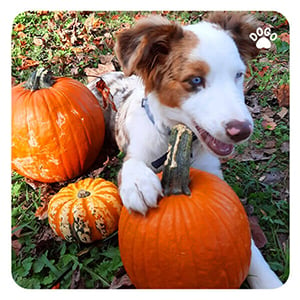 Pumpkin, a fall favorite for many, can also be a beneficial addition to your dog’s diet. Whether it’s for digestive issues or just as a tasty treat, many dog owners wonder about the right amount of pumpkin to give their furry friends. Let’s talk about how much pumpkin is safe and beneficial for your dog and how to incorporate it into their diet.
Pumpkin, a fall favorite for many, can also be a beneficial addition to your dog’s diet. Whether it’s for digestive issues or just as a tasty treat, many dog owners wonder about the right amount of pumpkin to give their furry friends. Let’s talk about how much pumpkin is safe and beneficial for your dog and how to incorporate it into their diet.
Understanding the Benefits of Pumpkin for Dogs
Pumpkin is a low-calorie, nutrient-dense food that is rich in fiber, vitamins, and minerals. The soluble fiber in pumpkin can help with digestive regularity, making it beneficial for both constipation and diarrhea in dogs. Additionally, it can help with weight management, as the fiber can make your dog feel fuller for longer periods.
The Right Amount of Pumpkin for Your Dog
When it comes to giving your dog pumpkin, moderation is key. For small dogs, a teaspoon or two of pureed pumpkin is generally sufficient. Medium-sized dogs can have a tablespoon or two, while larger dogs may benefit from two to five tablespoons of pumpkin per day. It’s important to note that these are general guidelines, and the amount may vary based on your dog’s size, weight, and any existing health conditions. Always consult your veterinarian before making significant changes to your dog’s diet.
Incorporating Pumpkin into Your Dog’s Diet
There are various ways to introduce pumpkin into your dog’s diet. You can mix a small amount of pureed pumpkin with their regular food, or freeze it in ice cube trays for a refreshing, fiber-rich treat. Some dog owners also use pumpkin as an ingredient in homemade dog treats, which can be a healthy and enjoyable way to incorporate this nutritious ingredient into your dog’s diet.
Potential Risks and Precautions
While pumpkin can be beneficial for many dogs, it’s essential to exercise caution and not overfeed it to your pet. Too much pumpkin can lead to an upset stomach or diarrhea. Additionally, it’s crucial to use plain, canned pumpkins without any added sugars or spices. Avoid pumpkin pie filling, as it often contains added sugars and other ingredients that can be harmful to dogs. Always read the labels to ensure you’re choosing the right kind of pumpkin for your pet.
Consulting with Your Veterinarian
Before making any significant dietary changes for your dog, especially when it comes to incorporating new foods like pumpkin, it’s always best to consult your veterinarian. They can provide tailored advice based on your dog’s individual needs, ensuring that you’re making the best choices for their health and well-being.
In conclusion, pumpkin can be a valuable addition to your dog’s diet when used in moderation. Its fiber content and nutrient profile can offer various health benefits, particularly for digestive health. By understanding the appropriate amount of pumpkin to give your dog and taking the necessary precautions, you can introduce this seasonal ingredient as a healthy and enjoyable part of your pet’s diet. Always prioritize your dog’s well-being and seek professional guidance when in doubt about dietary changes.[/fusion_text]


